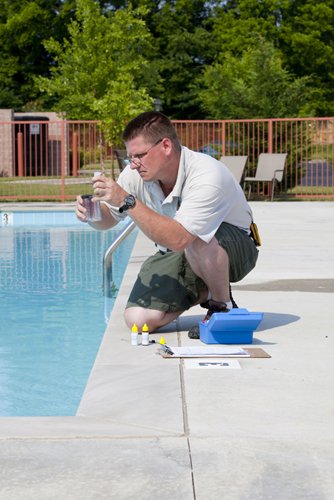Cyanuric acid is one of the rare chemicals that often ends up in the hands of people who are not scientists, researchers or engineers. It is used frequently in commercial and recreational outdoor pools, but has other commercial and laboratory applications as well. In communities that frequently deal with cyanuric acid – pool personnel and livestock feed engineers – the uses and side effects are well known, but for chemists and researchers outside of the loop there is a lot to learn about this interesting chemical.
What is it used for?
Cyanuric acid has many uses, but it is most popular and discussed as an additive for outdoor pools. Sometimes called "isocyanurates" or "CYA," cyanuric acid is used to condition or stabilize a pool's chlorine. Cyanuric acid has chemical reactions with free chlorine molecules to protect it from UV light and degradation from the sun. Some pool chlorine chemical compounds, such as dichlor and trichlor, release cyanuric acid into the pool without needing supplemental portions of the chemical added. These types are typically used in residential and small commercial pools, respectively.
On a typical bright sunny day, the chlorine used in a pool can almost completely disappear in two hours, because the free molecules will bond with water molecules. Cyanuric acid inhibits this action, but it also may lower the pH levels.
There are also a variety of other uses for this chemical, John Wojtowicz explained in the Journal of the Swimming Pool and Spa Industry.
"Cyanuric acid has a number of important non-pool uses, which include preparation of high performance magnetic-wire enamels, and in electrical varnishes, plastics with enhanced properties, flame-retardant resins and solid lubricants, cross-linking and curing agent in the manufacture plastics and coatings. CA is also used to reduce nitrogen oxides in stationary diesel engine exhaust gases," Wojtowicz wrote.
Cyanuric acid can be used as a U.S. Food and Drug Administration-approved feed-grade ruminant food additive, as well.
Essentially non-toxic
Cyanuric acid was in the news in 2007 as part of a pet food recall. The chemical was potentially used in the food with melamine, which can make the product test as though it has high protein levels when it does not necessarily. A World Health Organization investigation of the incident and a separate melamine issue about baby formula in China found that cyanuric acid was not toxic to animals or humans. However, when ingested along with melamine, there was evidence of renal failure in cats. Experts have called cyanuric acid essentially non-toxic.
In pools, many U.S. states have put restrictions in place for how much cyanuric acid should be used. Although, the driving force for using lower levels of cyanuric acid isn't necessarily danger, but often cost and efficiency. As cyanuric acid does not dissolve from the water like chlorine and it can reduce the effectiveness of chlorine as a sanitizer, there is no benefit to using too much.
In Pennsylvania for example, the upper limit of cyanuric acid use is 80 parts per million, the state's department of health explained. About 30 ppm may be a better number, pool experts explain, because that will maximize the longevity of the chlorine without drastically altering its effectiveness. Even amounts as low as 2 or 3 ppm are touted as optimal by some. Everything above 50 ppm makes the chlorine take longer to kill bacteria.
This is why cyanuric acid is not recommended for use in hot tubs or jacuzzis. The chemical also should not be used with indoor pools as there is no significant number of UV rays. It is also not required in pools or spas that use bromine because UV degradation is not an issue.
Cyanuric acid can be a great tool for pool operators when used in the proper dosage, because it is difficult to remove from the water.



